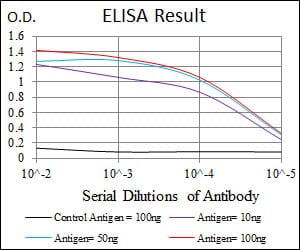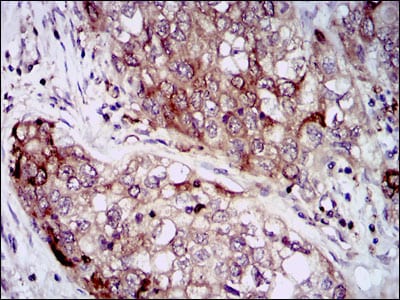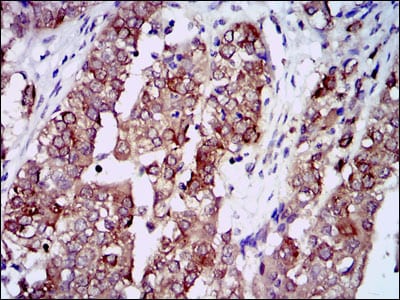




| WB | 咨询技术 | Human,Mouse,Rat |
| IF | 咨询技术 | Human,Mouse,Rat |
| IHC | 1/100-1/300 | Human,Mouse,Rat |
| ICC | 技术咨询 | Human,Mouse,Rat |
| FCM | 咨询技术 | Human,Mouse,Rat |
| Elisa | 1/5000-1/10000 | Human,Mouse,Rat |
| Aliases | HSPN; LAP2; HSP86; HSPC1; HSPCA; Hsp89; Hsp90; HSP89A; HSP90A; HSP90N; HSPCAL1; HSPCAL4 |
| Entrez GeneID | 3320 |
| clone | 5G5 |
| WB Predicted band size | 90kDa |
| Host/Isotype | Mouse IgG1 |
| Antibody Type | Primary antibody |
| Storage | Store at 4°C short term. Aliquot and store at -20°C long term. Avoid freeze/thaw cycles. |
| Species Reactivity | Human,Mouse,Monkey |
| Immunogen | Purified recombinant fragment of human HSP90AA1 expressed in E. Coli. |
| Formulation | Purified antibody in PBS with 0.05% sodium azide |
+ +
以下是3-4条与FLT3抗体相关的代表性文献示例(内容基于学术研究背景概括,具体文献请通过学术数据库核实):
---
1. **文献名称**:*Targeting FLT3 mutations in AML: review of current knowledge and evidence*
**作者**:Stone RM, et al.
**摘要**:综述了FLT3突变在急性髓系白血病(AML)中的致癌机制,探讨了FLT3靶向抗体(如抗FLT3单抗)及小分子抑制剂(如Midostaurin)的临床前和临床研究进展,强调抗体药物在克服耐药性中的潜力。
2. **文献名称**:*A monoclonal antibody targeting FLT3 eliminates leukemia stem cells in AML*
**作者**:Levis MJ, et al.
**摘要**:报道了一种新型抗FLT3单克隆抗体的开发,该抗体通过阻断FLT3受体信号通路,在小鼠模型中显著抑制AML白血病干细胞增殖,并延长生存期,为靶向治疗提供了实验依据。
3. **文献名称**:*FLT3 antibody-drug conjugates for acute myeloid leukemia therapy*
**作者**:Serve H, et al.
**摘要**:研究了一种FLT3抗体-药物偶联物(ADC)的疗效,证明其能选择性结合FLT3阳性AML细胞,通过释放细胞毒性药物杀伤肿瘤细胞,且对正常细胞毒性较低,提示ADC策略的转化前景。
4. **文献名称**:*Resistance mechanisms to FLT3 inhibitors and therapeutic implications*
**作者**:Smith CC, et al.
**摘要**:分析了FLT3靶向药物(包括抗体和小分子药物)的耐药机制,如继发性突变或代偿通路激活,提出联合使用FLT3抗体与PI3K/AKT通路抑制剂可能改善疗效。
---
**建议**:通过PubMed、Web of Science等平台,以“FLT3 antibody”、“FLT3-targeted therapy”、“AML FLT3 inhibitor”为关键词检索最新文献,重点关注近5年高被引论文或临床试验报告(如NCT编号研究)。
FLT3 (FMS-like tyrosine kinase 3) is a receptor tyrosine kinase belonging to the class III subfamily, primarily expressed in hematopoietic stem and progenitor cells. It plays a critical role in cell survival, proliferation, and differentiation by binding to its ligand, FLT3L. Aberrant FLT3 signaling, particularly through activating mutations like internal tandem duplications (FLT3-ITD) or tyrosine kinase domain mutations (FLT3-TKD), is strongly implicated in acute myeloid leukemia (AML). These mutations drive uncontrolled cell growth and are associated with poor prognosis, making FLT3 a key therapeutic target.
FLT3 antibodies are essential tools in research and diagnostics. They enable detection of FLT3 expression levels, mutation status, and phosphorylation events via techniques like flow cytometry, immunohistochemistry, or Western blotting. In clinical settings, FLT3 antibodies are used to identify AML subtypes and monitor residual disease. Therapeutic anti-FLT3 antibodies are also under exploration to block ligand binding or receptor activation, though small-molecule inhibitors (e.g., midostaurin, gilteritinib) currently dominate targeted therapy.
Research continues to refine FLT3 antibody specificity and applications, particularly in understanding resistance mechanisms and optimizing combination therapies. Their role in both basic science and translational medicine underscores their importance in advancing AML treatment strategies.
×